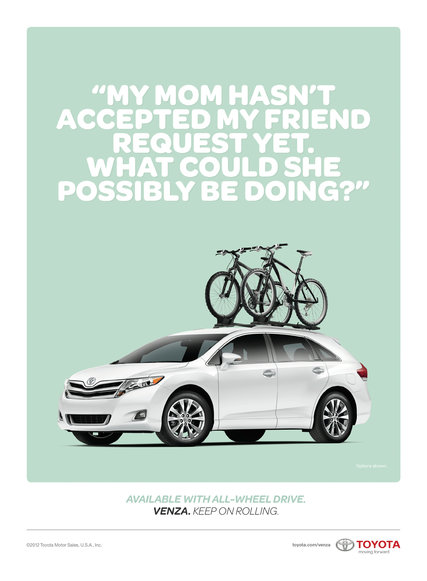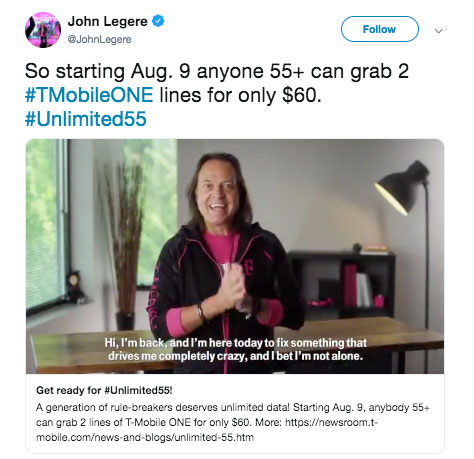Many of the world’s biggest brands have shifted their sights to targeting the Millennial demographic and making lifelong customers out of its members. But a few companies have taken a different approach. With Baby Boomers retaining the most spending power among all generations for the foreseeable future, a handful of brands have spotted the opportunities that marketing to Baby Boomers offers and are adapting their strategies accordingly.
You can apply these same strategies when marketing to Baby Boomers in the senior living industry.
1. Tailor Your Product to Meet Their Needs (T-Mobile)
T-Mobile’s strategy for marketing to Baby Boomers and tailoring their products to meet their needs may have you questioning whether you really understand what consumers ages 55 and above really want in a product.
The phone carrier’s leading strategists identified what they believed was the No. 1 feature older adults are looking for when purchasing a phone: the ability to stay connected with family and friends. Their response was to unveil a new data plan targeted toward customers in the 55+ demographic that would allow them to purchase the latest smartphones without some of the added bells and whistles that cause some plans to be so expensive. It’s a far cry from the obsolete flip phones with big buttons and limited minute plans that competitors tout as specially made for seniors.
Sometimes it can be easy to confuse what you want for your customer with what they want from themselves. That’s why, on many occasions, the best solution is the simplest one: Ask them. That’s what we always recommend to our clients.
Whenever a client is considering an expansion, we always recommend that they conduct surveys and hold focus groups so that they can hear directly from the customer about their wants and needs. It’s during these moments that you’ll discover what your customer’s must-haves are, as well as the things that will turn them away from your offering.
As T-Mobile’s CEO John Legere put it, “This generation deserves a little respect!” He’s right — and it’s time marketers start giving it to them.
2. Cater to Their Aspirations (Toyota)
Baby Boomers were the focus of the “Keep on Rolling” ad, which promotes the Toyota Venza and first aired in 2011. The commercial features an adult child commenting on her parents’ inactivity on social media while her parents are out engaging in the activities they love (in this case, mountain biking with friends).
 The ad speaks to the aspirations of older consumers. The couple continues to be active as they age, and members of this demographic viewing the commercial likely want to live in a similar manner for as long as possible — this ad just reinforces that desire. In the ad, Boomers aren’t portrayed as old, stagnant or technologically inept. It’s the adult child who is portrayed as living in somewhat of a distorted reality and lost in the world of social media.
The ad speaks to the aspirations of older consumers. The couple continues to be active as they age, and members of this demographic viewing the commercial likely want to live in a similar manner for as long as possible — this ad just reinforces that desire. In the ad, Boomers aren’t portrayed as old, stagnant or technologically inept. It’s the adult child who is portrayed as living in somewhat of a distorted reality and lost in the world of social media.
At Creating Results, we believe one of the flaws of generational marketing is the notion that one generation has to be brought down in order to elevate another one. With that said, the ad does make us want to take another look at how the senior living industry is marketing to Baby Boomers.
Many ads are still overly clinical, depict seniors as inactive or include copy or imagery that doesn’t align with the customer’s aspirations. Think about some of the activities that residents at your community like to participate in. We have clients whose residents enjoy swimming, hiking, biking and more. We make sure to depict these types of activities in ads for our clients when marketing to Baby Boomers to show that they can continue pursuing their interests and engaging in active living at a senior community. We’d recommend the same approach to any marketer in the industry: Use lifestyle to appeal to the customer.
3. Create a Pleasant Purchasing Experience (John Lewis)
Baby Boomers have singled out John Lewis among their favorite brands which is no small feat considering the department store brand doesn’t target Boomers exclusively. A quick look at their website shows that that they cater to various demographics, but where they earn points with Boomers is for their exemplary staff and service, ease of shopping and clear brand values.
Think about the experience you’re creating for your customer. Are you hiding prices and making your customer provide their personal details to access basic information about your community? Our Social, Silver Surfers study shows that these types of practices are a deterrent for customers. It makes it harder for them to learn about your product, and easier for them to eliminate you from consideration.
While we’re not against keeping some items behind a gate until a form is filled out, we recommend only doing this for one or two pieces of cornerstone content, such as more in-depth guides offering value the customer won’t get elsewhere.
Also consider the people who act as the faces of your brand. For 55+ and senior living communities, the members of the sales team are responsible for nurturing the relationship between the brand and the customer. Long wait times, unreturned calls, inaccurate information and other elements of poor customer service will not win you any fans. That’s why it’s important to have a well-trained sales team that prioritizes the customer over the sale and can communicate how the brand’s offerings align with the customer’s wants and needs.
4. Innovate, but Don’t Eliminate When Marketing to Baby Boomers (Geico)
In addition to creating ads specifically targeted to Baby Boomers (such as the “Peter Pan Reunion” commercial below), Geico has allocated resources to modern marketing channels, such as digital, in addition to more traditional channels, such as print.
This strategy has seen them gain more Baby Boomer customers than any other insurance company in the past five years. Why? Because they’re targeting Boomers on all the channels where they consume media and creating ads that appeal to them.
We recommend a mix of tactics for our clients. Some may be hesitant to invest in digital because they doubt its effectiveness with older demographics, while others may think print is outdated and that a fully digital approach will bring in the leads they desire. But, you can leverage more targeted approaches using both traditional and digital media to increase your marketing’s overall effectiveness.
Still, the investment is only as effective as your marketing’s content, and this is where Geico is able to take the lead with Baby Boomers. Content and imagery should capture the imagination of your target audience, speaking to their aspirations and offering a solution for the problem they’re trying to solve.
The reason why brands such as Geico and T-Mobile have been successful marketing to Baby Boomer consumers is because they’ve taken the time to understand their wants and needs and have adapted their strategy accordingly. Are there brands that you believe are leading the way when it comes to targeting Boomers? Let us know by leaving a comment below!




